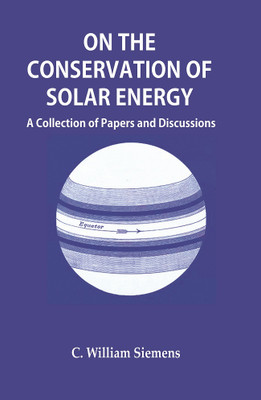On the Conservation of Solar Energy : A Collection of Papers and Discussions(Paperback, C. William Siemens)
Quick Overview
Product Price Comparison
About The Book : When, a twelvemonth ago, I ventured to communicate to the Royal Society my hypothesis regarding the Conservation of Solar Energy, I thought it advisable to confine myself to a concise statement of my views, in order to fix the attention of my audience upon the principles of action which I wished to submit for their consideration. That audience, comprising astronomers and physicists more familiar with the intricacies of solar physics than I could pretend to be, would, I thought, prefer the simple statement of my views to an elaboration of proofs, some of which they might possibly have deemed superfluous, and others objectionable in leading their attention away from the simple conception to matters of detail. In the short space of time which has elapsed since the reading of my paper, the amount of positive information regarding solar physics has been greatly augmented. The elaborate report to the American Government regarding the eclipse of 1880 had not appeared at the time I prepared my paper, but has since furnished a striking confirmation of the luminous equatorial extension of the sun which I had represented in a hypothetical diagram; other valuable information has been furnished, by observations in Egypt, of the solar eclipse of last year. The spectroscope, in the hands of Captain Abney and of Professor Langley, has furnished important evidence to the effect that solar rays are absorbed before they reach the outer confines of our atmosphere, pointing to the existence between the two atmospheres of a highly-attenuated medium comprising, according to Captain Abney, hydrocarbons of the ethyle group. The light thrown upon the diflferential motion of the photosphere by Mr. Carrington has been supplemented by the elaborate series of observations on the motion of sun-spots by Dr. Spoerer of Potsdam, and by very recent communications to the Paris Academy by M. Faye, who, although not admitting my hypothesis of a polar inflow current, has resorted to a polar outflow current in order to explain the photospheric polar retardation, and the cyclonic action to which the appearance and motion of sun-spots are attributable. About The Author : Sir Carl Wilhelm Siemens FRS FRSA (4 April 1823 ŌĆō19 November 1883), anglicised to Charles William Siemens, was a German-British electrical engineer and businessman. Siemens was born in the village of Lenthe, today part of Gehrden, near Hanover where his father, Christian Ferdinand Siemens (31 July 1787ŌĆō16 January 1840), a tenant farmer, farmed an estate belonging to the Crown. The Siemens family is an old family of Goslar which has been documented since 1384. His mother was Eleonore Deichmann (1792ŌĆō8 July 1839), and William, or Carl Wilhelm, was the fourth son of a family of fourteen children. Of his siblings, Ernst Werner Siemens, the fourth child, became a famous electrician and was associated with William in many of his inventions. He was also the brother of Carl Heinrich von Siemens and a cousin of Alexander Siemens. Siemens had been trained as a mechanical engineer, and his most important work at this early stage was non-electrical; the greatest achievement of his life, the regenerative furnace. Though in 1847 he published a paper in Liebig's Annalen der Chemie on the 'Mercaptan of Selenium,' his mind was busy with the new ideas upon the nature of heat which were promulgated by Carnot, Clapeyron, Joule, Clausius, Mayer, Thomson, and Rankine. He discarded the older notions of heat as a substance, and accepted it as a form of energy. Working on this new line of thought, which gave him an advantage over other inventors of his time, he made his first attempt to economise heat, by constructing, in 1847, at the factory of John Hick, of Bolton, an engine of four horse-power, having a condenser provided with regenerators, and using superheated steam.


